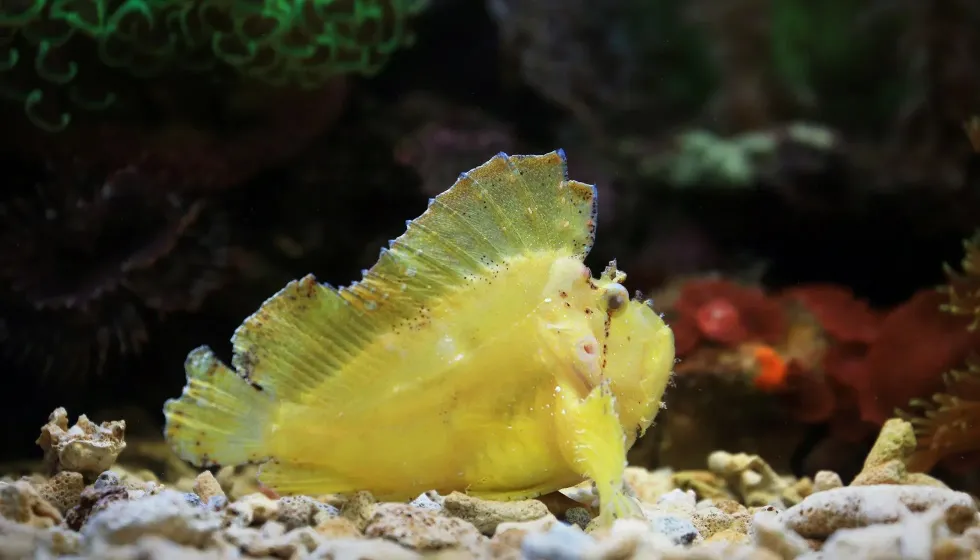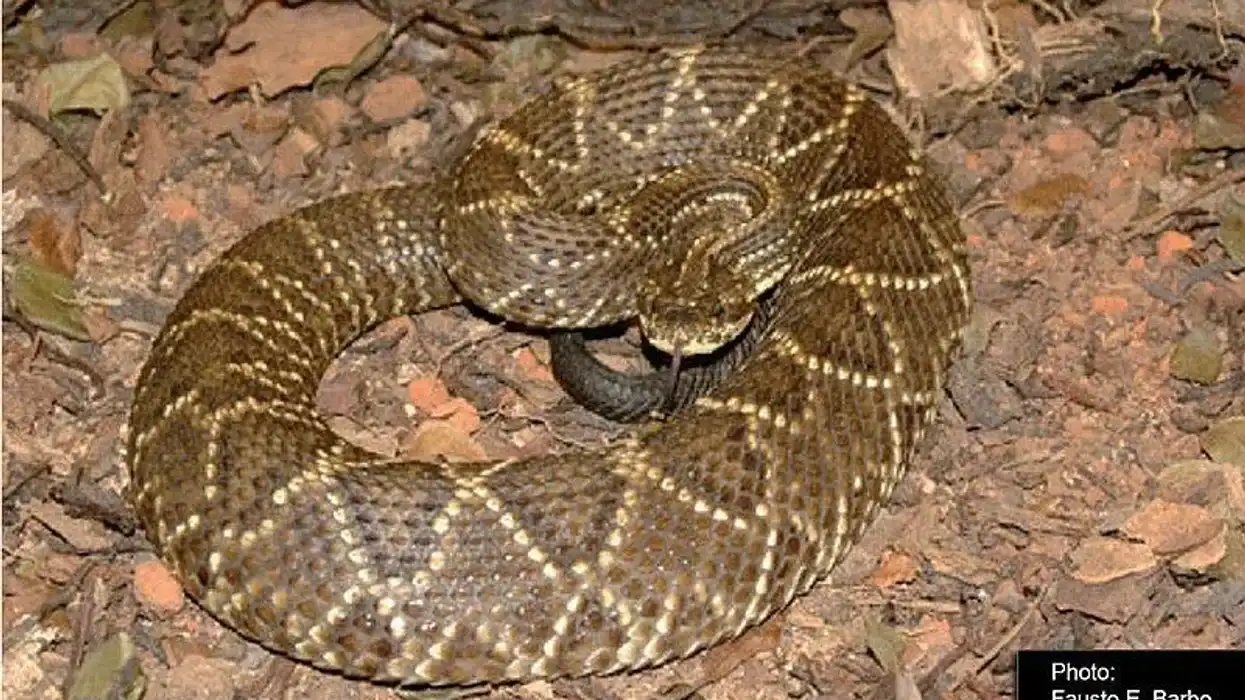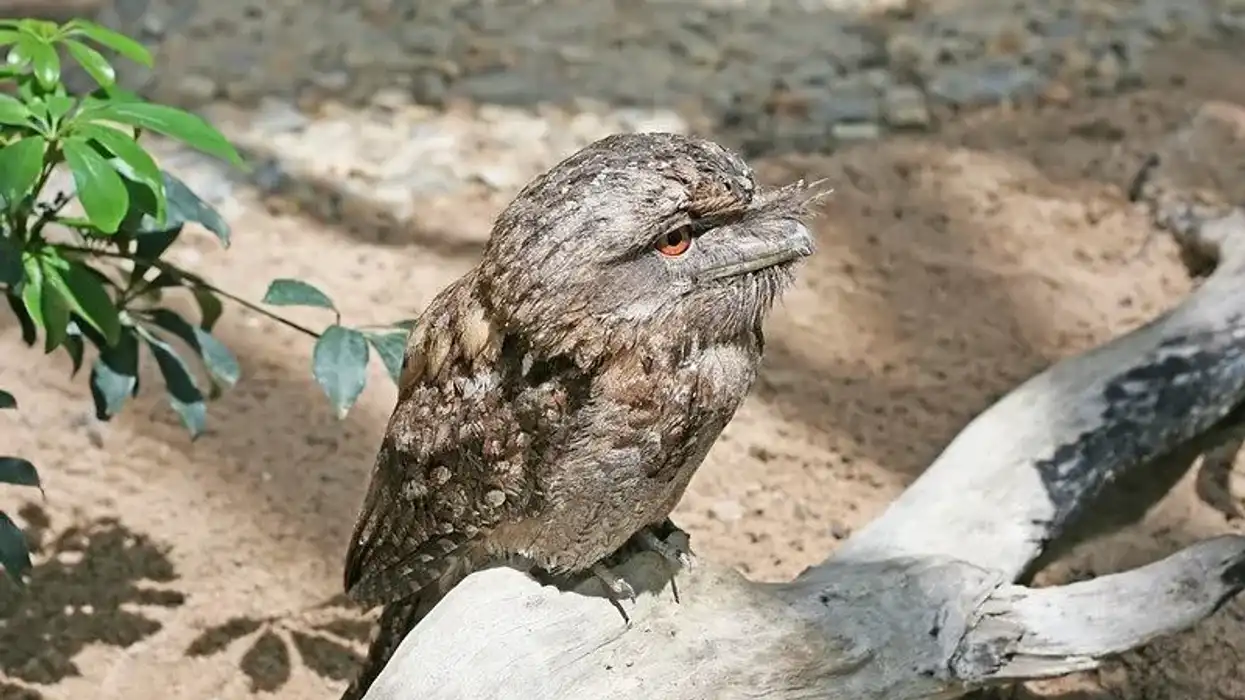The Ambon Scorpionfish (Pteroidichthys amboinensis) is a fish species native to the Indo-West Pacific Ocean and found along shores, usually at depths between 9.8-131.2 ft (3-40 m). These fish belong to the family of some of the world's most venomous fish, Scorpaenidae.
These fish have a shaggy, hairy body, a largemouth, projections above their small eyes, large pectoral fins, and small, venomous spines along their dorsal fin.
The Ambon Scorpionfish range is found along the coasts of the Red Sea, Yellow Sea, Australia, Indonesia, and Fiji. These fish have the ability to camouflage and live mostly in soft-bottom regions among algae.
These are ambush predators, and their feeding habits involve camouflaging into the background while they wait for their prey to come close before gulping them in through their largemouth.
When the Ambon Scorpionfish (Pteroidichthys amboinensis) is disturbed, they will raise the spines along their back, which release a highly poisonous mucus that can cause death. These fish are considerably rare, with only four records in an identifiable place of collection.
The exact number of existing mature individuals is unknown, but their population is not threatened and the IUCN has given them the conservation status of Least Concern.
If you like exploring marine animals, check out the Cownose Ray and the Rainbow Trout.
Ambon Scorpionfish Interesting Facts
What type of animal is an Ambon scorpionfish?
The Ambon scorpionfish is a venomous fish found in the waters of the Indo-west Pacific Ocean.
What class of animal does the Ambon scorpionfish belong to?
The Ambon scorpionfish (Pteroidichthys amboinensis) belongs to the class of Actinopterygii under the family Scorpaenidae and genus Pteroidichthys.
How many Ambon scorpionfish are there in the world?
The Ambon scorpionfish is a rare fish and their exact population numbers are unknown.
Where does the Ambon scorpionfish live?
The Ambon scorpionfish live in the algae-rich waters of the Indo-West Pacific Ocean and the Yellow and the Red Sea. These fish are native to Australia, India, China, Indonesia, Fiji, Vietnam, Korea, Philippines, Taiwan, and Timor-Leste.
What is an Ambon scorpionfish habitat?
The Ambon scorpionfish (Pteroidichthys amboinensis) live just off the shore at depths between 9.8-131.2 ft (3-40 m). They live in algae-rich waters with sandy or muddy bottoms, especially coastal reefs.
Who does the Ambon scorpionfish live with?
From the minimal observations of the Ambon scorpionfish, it is known that these fish are semi-aggressive in nature and live alone in a fish-only environment.
How long does an Ambon scorpionfish live?
The lifespan of the Ambon scorpionfish (Pteroidichthys amboinensis) has not been recorded. However, it is observed that most scorpionfish species live for about 15 years, similar to the lifespan of the Koi.
How do they reproduce?
Although not much is known about the reproduction system of the Ambon scorpionfish, in general, most scorpionfish share the same mating behavior. These fish are known for their solitary nature but get involved with other individuals only when mating.
Most of these fish produce around a hundred to a thousand eggs and they are ovoviviparous, which means the eggs hatch inside the body of the female.
However, the fish from the Scorpaeninae family, the same as the Ambon scorpionfish, lay eggs in gelatinous masses that float towards the water's surface.
Eventually, the eggs start hatching into larvae which have large elliptical yolk sacs, pectoral fin buds, transparent eyes, and no mouth. Their body develops various parts and the young grow out of the planktonic stage quickly.
What is their conservation status?
Although this fish is relatively rare, their population does not seem to be threatened by any natural or artificial factors. As a result, the IUCN evaluation of this fish has declared the conservation status of Least Concern.
Ambon Scorpionfish Fun Facts
What does the Ambon scorpionfish look like?
Although these fish have been spotted in a red-brown shade, they have the ability to camouflage, which means they will adapt to the color of their surroundings when feeding or capturing prey. These ray-finned fish have a shaggy body with small venomous spines along their dorsal fin that can cause death.
They have highly flexible, hairy bodies and can bend even under minimal pressure. This fish has a large mouth, head and pectoral fins with long branch-like projections around their eyes.
How cute are they?
These fish do have vibrant colors when they choose to display it, but their overall appearance can be shabby hair-like, which is not very cute.
How do they communicate?
Since minimal studies have been conducted on this rare fish, not much information is found about their communication habits and behavior. In general, most species of scorpionfish use motion and noises, especially by vibrating the swim bladder, to communicate.
During mating, some of these species swim in small circles around each other until the female is impressed by the male.
How big is the Ambon scorpionfish?
This fish is quite small in size and are around 3.14-4.72 in (8-12 cm) long, which is slightly smaller in size than the Rainbow Cichlid. The species of this family have shown signs of females growing larger than the males. The hatchlings are barely an inch long when they are born.
How fast can an Ambon scorpionfish swim?
Due to its rarity, not much is found about the speed at which this fish swims. However, it is known that most scorpionfish species are primarily found motionless, waiting to catch prey. When in danger or when catching their prey, these fish can move swiftly in a lunge-like motion.
How much does an Ambon scorpionfish weigh?
They are light small-size fish, but their weight is unknown. However, most fish from the Scorpaenidae family weigh around 3-3.4 lb (1.36-1.54 kg).
What are the male and female names of the species?
The male and female Ambon scorpionfish do not have separate names and are referred to as male or female scorpionfish.
What would you call a baby Ambon scorpionfish?
When the eggs hatch, they are known are larvae, but once they grow up, they can be called juvenile or young Ambon scorpionfish.
What do they eat?
The Ambon scorpionfish is carnivorous and is found feeding on small fish, mollusks like snails, and crustaceans like crabs, lobsters, and shrimp. Sometimes, they also feed on their kind. They hunt by camouflaging into the surrounding algae as they wait for the prey to come close before snatching it into their large-sized mouths.
Are they dangerous?
Yes, these fish have spines coated in poisonous mucus along their dorsal fin. The Ambon scorpionfish venom type is hazardous and has even been found to cause death. These spines usually come out when they are hunting for food or feel threatened.
Would they make a good pet?
Despite their rarity, these fish are known to be kept in captivity, but they can be fatal due to their venom. These fish have a semi-aggressive nature with a carnivorous diet, so keeping them in the same tank as smaller fish or crustaceans is not advised.
If kept with other animals, it needs to be with peaceful creatures in a fish-only environment. They can be kept among the coral in tank with at least 50 gallons of water.
The water temperature must be maintained at 72-80℉ ( 22.22-26.66 ℃) with a pH level between 8.0-8.5. Overall, they are best kept one per aquarium, and you must be extra careful when you are interacting with them because of their venom.
Did you know...
Lionfish and scorpionfish belong to the same order of ray-finned fish called Scorpaeniformes. The difference between a scorpionfish and a stonefish is that stonefish is very venomous whereas scorpionfish is a mild stinger.
Are Ambon scorpionfish poisonous?
Yes, these fish are considered highly venomous due to the toxic mucus present on the spines of their dorsal fin, similar to the Rockfish. Their venom is known to cause death as well.
Therefore, it is suggested that the person who has been stung immediately get medical attention. Depending on the severity of the sting, symptoms may include severe pain, swelling, rashes, headaches, diarrhea, increased heart rate, various other allergic reactions.
What happens if you touch a scorpionfish?
Scorpionfish can be highly poisonous because of the spines on their back. If startled or touch incorrectly, you can get stung and experience pain, in some cases even death.
After getting to a medical professional, they will clean and soak the affected area in warm water for half an hour to an hour. Later, the visible spines are removed and further medical care is provided to treat the effects of the venom.
Here at Kidadl, we have carefully created lots of interesting family-friendly animal facts for everyone to discover! For more relatable content, check out these Wels Catfish facts and Humphead Wrasse facts pages.
You can even occupy yourself at home by coloring in one of our free printable fish coloring pages.









